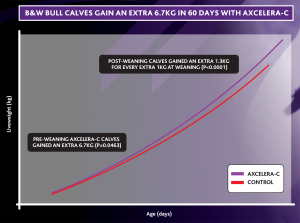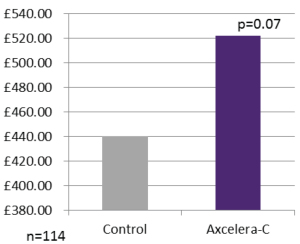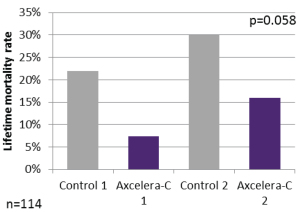Download Original Article: Beef Farmer Magazine - Spring 2016
Beef farmers are looking for new ways of improving their stock's performance and their unit's profitability. Innovative beef farmers in the UK have started to use a new product that was originally designed to help accelerate dairy calf performance.
Axcelera-C is a very palatable high lactose pellet that was developed in 2008 in the Czech Republic using a unique 'Neo-Tec' low temperature system to ensure all of the ingredients are processed gently. Dairy farmers in the harsh Czech winters struggled to keep the liquid calf milk replacers offered to calves sufficiently warm and so often fed sub-optimal milk resulting in nutritional scours and poor calf development. To address this problem and to make life easier for dairy farmers, a new way of offering milk to calves was developed that did not need mixing into a warm liquid, but could be offered as a solid, replacing one of the liquid milk feeds each day. Because the calf is the most efficient lifestage and accelerating calf development is the key to lifetime performance, Axcelera-C is now used in addition to the existing milk program to maximise intakes and calf performance.
1 million calves
Since 2008 over 1 million calves have been raised and accelerated overseas using Axcelera-C technology and this system has now been made available to the UK ruminant market. AB Neo (a division of AB Agri UK) acquired the technology and through extensive R&D, both the formulation and how it is used on-farm have been improved, producing a flexible system that beef and dairy farmers can use to achieve their objectives.
It's all about the neonate
AB Neo (A division of AB Agri) believes that the neonate (baby animal) holds the key to switching on lifetime performance in animals. There are specific ways we can influence the development of neonates that will then enhance their lifetime yield and performance, recognising that if we miss the neonatal window, opportunities to program the animal for higher lifetime productivity can never be recovered. Axcelera-P, the swine equivalent of Axcelera-C reduces pre-weaning mortality and improves lifetime performance so pigs can be slaughtered heavier and earlier. That is achieved by changing only what the piglet eats from day 4 up to weaning. A combination of different epigenetic factors are understood to deliver the accelerator-effect that has already helped Axcelera-P to become the UK's top-selling pre-weaning diet for pigs. In a similar way, Axcelera-C is seeking to 'reprogram' the calf for improved lifetime performance.
Axcelera-C is offered to calves from day 3 until weaning and because it is a highly palatable solid it is consumed earlier in larger quantities than a starter feed, entering the rumen sooner where it is digested and stimulates early rumen development which is essential for determining the calf's development and lifetime performance.
Earlier weaning
Dairy farmers are seeing accelerated calf development which results in weaning several weeks earlier and because the rumen is better developed there is less of a check in growth at weaning - meaning growth momentum is maintained. Farmers are seeing their calves routinely cudding at 2 weeks with reductions in the incidence and severity of nutritional scours and an overall improvement in health and vitality which has led to fewer interventions and injections.
Accelerated beef development

Fig 1: Accelerated calf growth
Beef farmers have also started to use Axcelera-C on their units to accelerate the performance of their stock. One such farmer is Gary Allis (Beef Farmer of the Year - Finalist 2015) from Lincolnshire, using the Buitelaar system on black and white bulls. Black and white calves will typically come onto farm at 28 days of age and will only first start to be offered Axcelera-C nearly 4 weeks later than their dairy equivalents. As such it would be conceivable that the 'neonate window of opportunity' may have been missed. However the results speak for themselves and have helped to transform the farm's performance.
AB Neo followed 2 groups of Axcelera-C calves on Gary Allis' farm, through to slaughter with the following results:
- 50% reduction in mortality in Axcelera-C calves (p=0.058)
- Calves grew significantly faster than conventionally-reared calves
- Carcass value of the finished cattle was improved
- Overall minimum ROI of 4:1
How much more effective would the performance be if the B&W bulls received Axcelera-C from day 3? Could there be a possibility of ensuring the B&W bulls are offered Axcelera-C from day 3 at the feeder farms to optimise bull calf development and performance in line with dairy heifer calves?
 Fig 2: Improved average carcass value |
 Fig 3: Reduction in lifetime mortality |
Optimising lactose intakes for high performing calves
Calf rearers understand the vital role that calf milk replacers play in raising high performing calves, with some farmers choosing to offer 500g of calf milk replacer a day, and others twice as much by offering 1000g per calf per day. They use twice as much because they understand that will deliver better calves and better calf performance. If they could exceed 1000g a day, progressive farmers would choose to do so, but at these levels the abomasum becomes full and there is a far greater risk of nutritional scours.
By using Axcelera-C in addition to the liquid milk program means calf rearers can offer even more lactose and milk-proteins to their calves, but by being solid (unlike calf milk replacer) it enters the rumen where it is digested and stimulates early rumen development which is the key to accelerating calf development.
On-farm experience shows that Axcelera-C reduces nutritional scours and is therefore an easy way of accelerating calf growth and development working in harmony with the existing tried and tested milk system - whatever level the farmer is comfortable with.
On dairy farms, heifer calves are offered 100% Axcelera-C for the 1st 3 weeks. The high lactose pellets have an extremely attractive smell which means the calf will intake at 3 days of age, optimising intakes of a high quality lactose source directly into the rumen. This gives the rumen at least a one week head start over solid intakes with starter feed and with a formulation that is far more digestible to the calf in the first weeks of life.
Because Gary Allis is receiving calves on farm at 4 weeks of age, he offers Axcelera-C blended in at 15% with his starter feed, with each calf consuming on average approximately 15kg of Axcelera-C. He is seeing improved intakes up to weaning and because it is likely that the bull calves may have been less well cared for than heifer calves on dairy farms, the higher intakes of Axcelera-C help to support the health and development of the calves that are sourced from many different farms. The Axcelera-C being offered pre-weaning is the only change to Gary's system and that is reducing his lifetime mortality by 50%.
Other improvements seen on farm with Axcelera-C:
- Herd homogeneity. The calf weight variation is also reduced, where the smaller calves are improved, reducing variation and increasing overall growth and performance within the herd.
- Improved solid intakes. Axcelera-C calves consumed 12% more solids in the milk phase when they were at their most efficient.
More from less?
Axcelera-C is offered in addition to the existing liquid milk program to ensure there is as large an intake of lactose and milk proteins as possible. However, some recent advanced calf development work on an award-winning dairy farm has shown that by increasing Axcelera-C intakes and in time reducing liquid milk intakes, it is possible to wean calves at 35 days (as opposed to 50+ days), saving approx £14 per calf in rearing costs and still delivering a faster growing calf compared to a conventionally reared animal.
In summary, Axcelera-C offers UK beef farmers a new tool to use when rearing calves, and works in conjunction with the existing system to deliver faster growing calves that form the foundations for lifetime performance.

